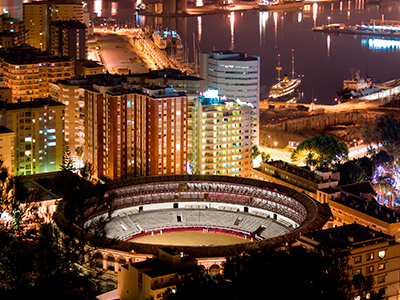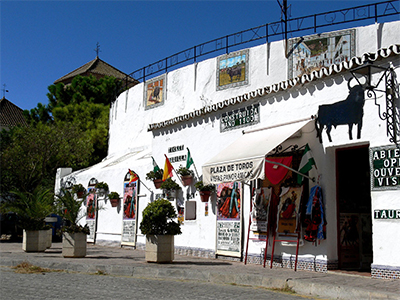
Bullrings in Malaga
- La Malagueta – Opened in 1876, capacity 14,000 spectators
- Ronda – Opened in 1785, capacity 6,000 spectators
- Antequera – Opened in 1848, capacity 8,200 spectators
- Benalmádena – Opened in 1968, capacity 3,600 spectators
- Carratraca – Opened in 1878, capacity 3,000 spectators
- Cortes de la Frontera – Opened in 1894 capacity 1,000 spectators
- Estepona – Opened in 1972, capacity 8,000 spectators
- Fuengirola – Opened in 1962, capacity 4029 spectators
- Gaucín – Opened in 1881 capacity 6,000 spectators
- Marbella – Opened in 1964, capacity 9,500 spectators
- Nueva Andalucía – Opened in 1968, 11,300 spectators
- Torremolinos – Opened in 1968, 3500 spectators
- Vélez-Malaga – Opened in 1894, capacity 5,000 spectators
History of Bullfighting
Bullfighting has existed in one form or another since ancient days. An unearthed wall painting which dates back to around 2000BC in Knossos in Crete, shows male and female acrobats confronting a bull, grabbing its horns as it charges, and vaulting over its back.
Bullfights were popular spectacles in ancient Rome, but it was in the Iberian Peninsula that the were fully developed. The Moors from North Africa who ruled Andalucia in711 AD changed bullfighting significantly from the brutal, formless spectacle which was practiced by the Visigoths to a ceremonial event which was held in connection with feast days, on which the Moors, mounted on horses, confronted and killed the bulls.
As bullfighting developed, the men on foot, who by their capework aided the horsemen in positioning the bulls, began to draw more attention from the crowd, and the modern’bull run’ began to take form. Today the bullfight is much the same as it has been since about 1726, when Francisco Romero of Ronda, Spain introduced the estoque (rapier) and the muleta (small, more easily wielded worsted cape used in the last part of the fight).
Bullfighting: Corrida de toros

Bullfighting in Spain is called corrida de toros (which translates to ‘running of bulls’) or la fiesta.
In the traditional bullfights there are three bullfighters who each have to fight two bulls. The bulls are aged between four and six years old and weights no more than 460kg.
Each bullfighter has six assistants, two lancers on horseback (picadores), three flaggers (banderilleros) and a sword page (mozo de espadas) this group of people are collectively known as an entourage (cuadrilla).
The modern bullfights are divided up into three different stages; the start of each stage is announced by the sound of a bugle.
In the first stage of the bull fight, the people taking part enter the bullring in a parade to salute the dignitary who is presenting the event this part of the bullfight is known as the paseillo.
Next, the bull will enter the ring at this stage the bullfighter and the lancers will test the bulls aggression with a gold and magenta cape. In the lancing third (tercio de varas) the bullfighter will confront the animal with the cape and perform a series of passes. These passes are to observe the mannerisms and behaviour of the animal.
After this a lancer will enter the area and stab the bull just behind the mound on the neck, this will lead to the first loss of blood of the animal. If this stab is performed correctly it will weaken the neck muscles and the way the animal charges at the horse will provide the bullfighter will important clues about which side favours. The bull will also hold its head and horns lower during the following stages of the fight.
The next stage of the fight is known as the third of the flaggers (tercio de banderillas) this is where each of the flagger attempts to place two sharp sticks into the bull’s shoulders.
The final stage is called the third of death (tercio de muerte). This is where the bullfighter enters the ring with a smaller red cape and a sword. The colour of the cape is in fact used to mask the bull’s blood not as many people think it is to anger the animal (as bulls are in fact colour blind).
This stage the bullfighter demonstrates his control over the animal with a series of passes and moves; this part of the fight is also to tire the bull even further. The final part is where the bullfighter manoeuvres the bull into position ready to stab it in the aorta or heart.
If the bullfighter has performed particularly well the audience may ask the president to award the fighter with one of the bull’s ears this is shown by the crowd waving white handkerchiefs if the bullfighters performance was considered to be exceptional he will be awarded both ears.
If the crowd or bullfighter believes that the bull has fought extremely bravely, the events president may be granted a pardon and if this is granted the bulls life will be spared and be allowed to leave the ring alive and return to the ranch it came from.
More information:
Portal Taurino – The ‘wikipedia’ of the taurine world.
PETA – Bullfighting – An alternative view of bullfighting from the well known animal rights organization, PETA.


